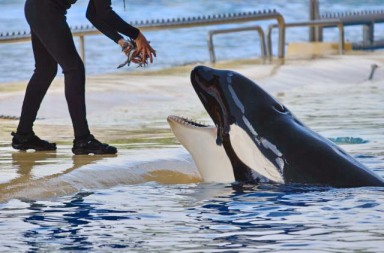I grew up near Newport Oregon, where I visited a male orca named Keiko several times a year. Keiko was best known for his movie role Free Willy in 1993 (Which I have never seen and don’t want to see). I remember playing with the giant orca, by running the length of the underwater viewing glass and having him chase me back and forth.
I remember Keiko had a bent dorsal fin. The tour guides insisted that he lived the first half of his life in a dangerously small pool, and was only able to swim in one direction. I believed them. I also believed that Keiko was receiving great care.
After watching Blackfish, I shudder to think what goes on behind the curtain at any orca housing facility. Blackfish followed the story of another famous male orca named Tilikum. I encourage you to watch the drama-documentary with a box of facial tissue nearby. In summary Tilikum can be linked to three killings, each of which surrounds accusations of cover-up.

Dawn with Tilikum
In 2010 Tilikum killed one of his experienced trainers, Dawn Brancheau, by pulling her underwater after a show. Initial eye-witness reports said that Brancheau was pulled in by her hair.
Later other reports surfaced that she was pulled in by her arm.
While the drama-documentary is mostly following the story of Tilikum, Blackfish puts a bright spotlight on SeaWord’s practices. SeaWorld is where Brancheau was killed and where Tilikum resides today.
Blackfish was released in January 2013. It has taken SeaWorld 12 months to publicly respond to the drama-documentary. You can read SeaWorld’s “The Truth about Blackfish” here.
I agree with many points SeaWorld makes about the continuity of Blackfish. Footage from recent performances was used to supplement the narration of former SeaWorld employees. As far as exhibiting corporate social responsibility, SeaWorld has a long way to go.
SeaWorld’s function is tri-fold
2. Conservation
These three functions fall under the larger umbrellas of corporate social responsibility; society, environment and economy.
But there are ethical (and moral) dilemmas surrounding each function. Starting with society’s education and research. Animal advocates don’t want to see orca’s being encouraged to adapt to human contact and conditioning. Also using animals for work or experimentation isn’t okay for many animal advocates. Both of these are taking place at SeaWorld, on a daily basis. Therefore, SeaWorld fails the first part of corporate social responsibility.
Second, the environmental conservation of orca’s. The current facilities the animals at SeaWorld live in are not mimicking of their natural habitat. This means that their pools are made from concrete and aren’t deep enough to simulate the ocean. Breeding animals for show purposes but labeling it as “conservation” is also a huge concern among animal advocates.
Third, using the orca’s as entertainment to make a profit. This is the essence of SeaWorld. Entertainment. Using large animals to perform tricks to rake in the dollars. The trainers are “performers” and the pool is the “stage”. The performers are paid and get to go home to their families while the orca’s are compensated with dead frozen fish soup and are penned up for the night.
SeaWorld offers daily performances because it bottom line is about dollars, not the care of the animals. If they did care about their animals, they would release the older whales into a open-sea pen and rely on donations to fund their research.
Since Blackfish premiered last year (January 2013), an angry public has taken to Twitter, Facebook and other social media to put pressure on Sea World sponsors to discontinue their partnership. Major corporations like Southwest Airlines continue to partner with SeaWorld. However several musical artists, including the Barenaked Ladies and Willie Nelson have cancelled their scheduled performances and encourage people to not attend SeaWorld.
SeaWorld is stepping up their public relations attempts by releasing videos of people featured in Blackfish, who talk about how they were made to look bad in the drama-documentary. About every five days @SeaWorld will Tweet out something about “don’t listen to activist hype” or “learn the truth”. Despite the negative attention, SeaWorld reported that it made record profits in 2013.
